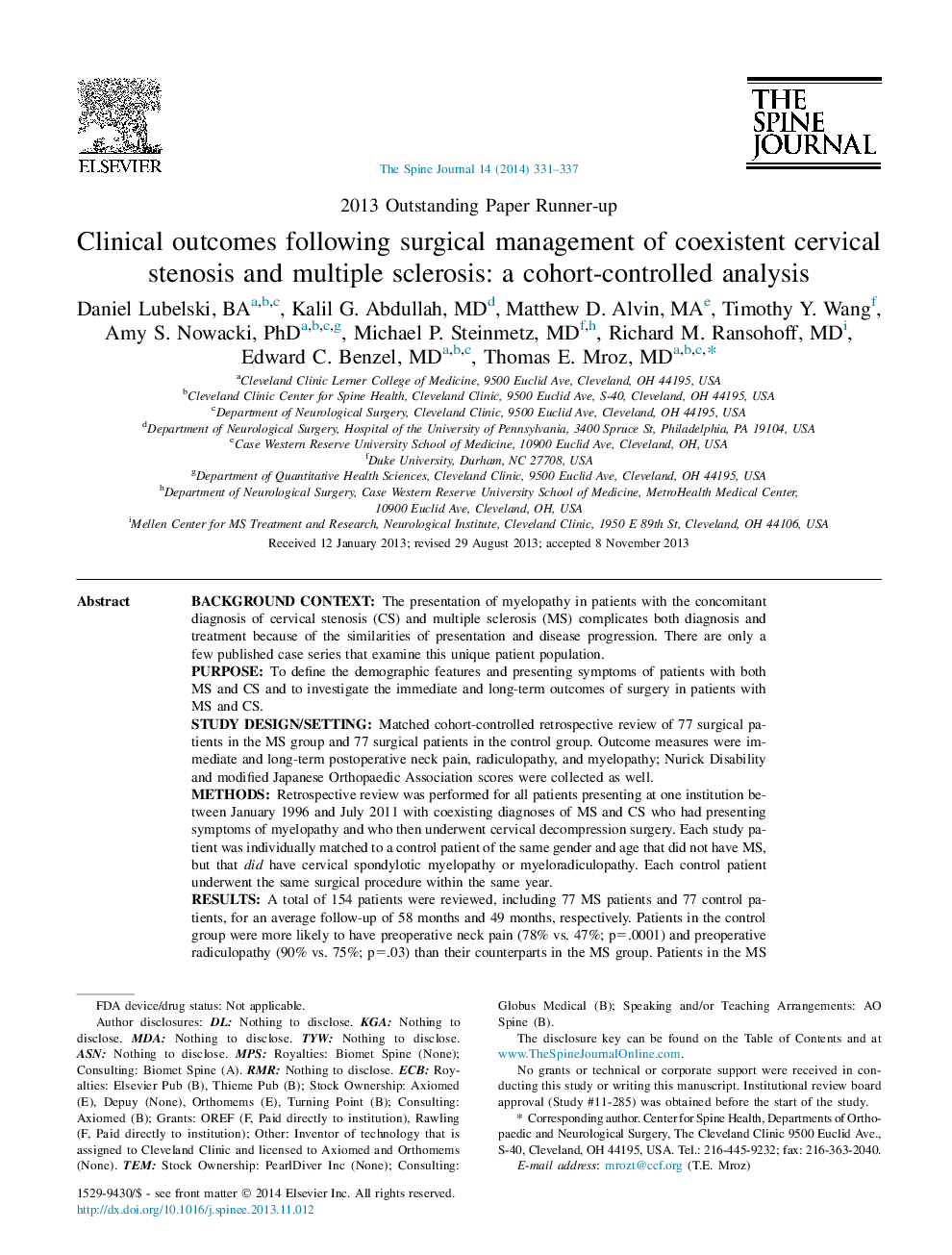| کد مقاله | کد نشریه | سال انتشار | مقاله انگلیسی | نسخه تمام متن |
|---|---|---|---|---|
| 6212895 | 1268605 | 2014 | 7 صفحه PDF | دانلود رایگان |
Background contextThe presentation of myelopathy in patients with the concomitant diagnosis of cervical stenosis (CS) and multiple sclerosis (MS) complicates both diagnosis and treatment because of the similarities of presentation and disease progression. There are only a few published case series that examine this unique patient population.PurposeTo define the demographic features and presenting symptoms of patients with both MS and CS and to investigate the immediate and long-term outcomes of surgery in patients with MS and CS.Study design/settingMatched cohort-controlled retrospective review of 77 surgical patients in the MS group and 77 surgical patients in the control group. Outcome measures were immediate and long-term postoperative neck pain, radiculopathy, and myelopathy; Nurick Disability and modified Japanese Orthopaedic Association scores were collected as well.MethodsRetrospective review was performed for all patients presenting at one institution between January 1996 and July 2011 with coexisting diagnoses of MS and CS who had presenting symptoms of myelopathy and who then underwent cervical decompression surgery. Each study patient was individually matched to a control patient of the same gender and age that did not have MS, but that did have cervical spondylotic myelopathy or myeloradiculopathy. Each control patient underwent the same surgical procedure within the same year.ResultsA total of 154 patients were reviewed, including 77 MS patients and 77 control patients, for an average follow-up of 58 months and 49 months, respectively. Patients in the control group were more likely to have preoperative neck pain (78% vs. 47%; p=.0001) and preoperative radiculopathy (90% vs. 75%; p=.03) than their counterparts in the MS group. Patients in the MS group had a significantly lower rate of postoperative resolution of myelopathic symptoms in both the short-term (39% in the MS group did not improve vs. 23% in the control group; p=.04) and the long-term (44% in the MS group did not improve vs. 19% in the control group; p=.004). Preoperative myelopathy scores were worse for the MS cohort as compared with the control cohort (1.8 vs. 1.2 in the Nurick scale, p<.0001; 13.7 vs. 15.0 in the modified Japanese Orthopaedic Association scale, p=.002). This difference in scores became even greater at the last follow-up visit with Nurick scores of 2.4 versus 0.9 (p<.0001) and modified Japanese Orthopaedic Association scores of 16.3 versus 12.4 (p<.0001) for the MS and control patients, respectively.ConclusionsMyelopathic patients with coexisting MS and CS improve after surgery, although at a lower rate and to a lesser degree than those without MS. Therefore, surgery should be considered for these patients. MS patients should be informed that myelopathy symptoms are less likely to be alleviated completely or may only be alleviated temporarily because of progression of MS and that surgery can help alleviate neck pain and radicular symptoms.
Journal: The Spine Journal - Volume 14, Issue 2, 1 February 2014, Pages 331-337
